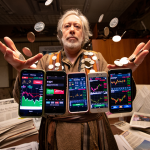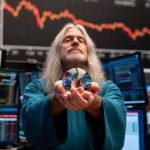
The Stochastic Trap: How Market Panic Devours the Weak and Feeds the Bold
Apr 15, 2025
Imagine this: The market cracks open like a fault line. Red charts bleed across the screen, orders vanish into the void, and the herd stampedes blindly into the abyss. The question isn’t if chaos will strike—it’s when. In this maelstrom, survival isn’t about speed; it’s about precision. The wolves know this. They don’t run—they calculate. And one of their sharpest weapons? The stochastic oscillator calculation.
It sounds innocuous, even mundane—a formula, a tool, a series of numbers. But don’t be fooled. This is no ordinary indicator. The scalpel cuts through the noise of panic, exposing the raw nerves of market momentum. Yet, in the wrong hands, it’s a loaded weapon pointed at your own portfolio. This is where fear meets opportunity, where greed collides with chaos, and where the few who understand the stochastic oscillator calculation rise above the carnage to hunt while others flee.
The Anatomy of Panic: Why the Herd Always Loses
Market crashes aren’t just numbers—they’re primal events. Every sell-off is a symphony of fear, driven by the same neurochemical responses that kept our ancestors alive in the wild. You’re not just watching a dip in price; you’re seeing the limbic system hijack rationality in real time.
Think back to 2008. The financial crisis wasn’t just a collapse of mortgages or derivatives—it was a collapse of confidence. Traders dumped assets, not because of logic, but because of cortisol. The same story played out in the dot-com crash, the COVID selloff, and every financial panic in history. Mirror neurons amplify the madness, cognitive dissonance locks people in denial, and the herd charges straight off the cliff.
And here’s the brutal truth: Most traders aren’t wired to survive this. They sell at the bottom, buy at the top, and repeat the cycle until their accounts are bled dry. But the wolves—the operators who move against the tide—they see panic for what it really is: an opportunity.
The Wolves Move Different
It’s easy to romanticize contrarian legends like Jesse Livermore, John Templeton, or Ray Dalio. But their genius wasn’t luck, and it wasn’t mysticism—it was calculation. They thrived because they mastered tools and mindsets the herd couldn’t comprehend. Livermore didn’t just short markets; he studied their lifeblood: volume, momentum, and sentiment. Templeton bought “at the point of maximum pessimism.” Dalio reduced chaos to principles and systems, turning uncertainty into a machine for wealth.
Now, take that mindset and apply it to the modern shadow operators—the ones who don’t make headlines but quietly dominate. They’re the traders who use tools like the stochastic oscillator calculation to dissect momentum with surgical precision. They know that markets, like quantum particles, exist in paradox: oversold but ready to bounce, overbought but teetering on collapse. The stochastic oscillator doesn’t just measure these extremes—it reveals the cracks in the system where profit lives.
And yet, this isn’t about the tool—it’s about the user. In the hands of the untrained, the stochastic oscillator is just another line on a chart. But in the hands of a predator, it’s a weapon. The wolves know how to read between the lines, to see the hidden signals that others miss, and to act decisively when the moment strikes.
Fear as Fuel: Strategic Options Play
Let’s break this down. Fear isn’t just an emotion—it’s raw energy. And in the markets, it manifests as volatility. When the VIX spikes and the herd panics, the wolves see an opening. One of their favorite plays? Selling puts. It’s a strategy that turns fear into immediate cash flow, capturing inflated premiums from traders desperate to hedge against further losses.
But here’s where the elegance comes in. The wolves don’t stop at collecting premiums—they reinvest them into LEAPS (Long-Term Equity Anticipation Securities). This is the long game: using short-term fear to fund long-range precision. It’s controlled chaos, a missile built from market panic that targets outsized returns over time. And the stochastic oscillator calculation? It’s the guidance system, pinpointing the optimal moments to strike.
Think of it like this: Selling puts during a volatility spike is the equivalent of standing in the eye of a hurricane while everyone else is blown sideways. Reinvesting those premiums into LEAPS is the act of planting seeds in scorched earth, knowing they’ll grow into forests when the storm passes. This isn’t gambling—it’s strategy. It’s war with a blueprint.
Calculated Aggression: The Line Between Confidence and Carnage
But make no mistake—this game isn’t for the reckless. The same volatility that creates opportunity can destroy those who act without discipline. The wolves understand this. They move with calculated aggression, like snipers on a battlefield. Every shot is deliberate, every trade measured, every risk accounted for.
The stochastic oscillator calculation acts as their scope, guiding their decisions with precision. It identifies overbought and oversold conditions, but more importantly, it reveals the moments when momentum is about to shift. The wolves don’t chase trends—they anticipate reversals. They know that the line between confidence and carnage is razor-thin, and they operate with the awareness that one misstep can be fatal.
This is the paradox of trading: to win, you must embrace risk, but you must do so with absolute control. It’s not about YOLO trades or blind bets—it’s about understanding the system, reading the signals, and executing with ruthless efficiency. And the stochastic oscillator? It’s not the answer—it’s the tool that helps you ask the right questions.
The Exit Velocity of Independence
Here’s where it all comes together. The wolves don’t just trade for profit—they trade for power. They understand that the ultimate goal isn’t money—it’s independence. Independence from fear, from noise, from the mental prison of the herd.
When you master tools like the stochastic oscillator calculation, you gain more than an edge—you gain clarity. You see the market for what it is: a battlefield of chaos and contradiction, where the only constant is change. You learn to move with the precision of a chess grandmaster, always thinking several steps ahead. And most importantly, you learn to trust yourself—to act decisively when others hesitate, to hold steady when others panic, and to exit when others are just beginning to hope.
This is the final paradox: Independence requires discipline. Freedom demands restraint. To escape the herd, you must first master yourself. And when you do, the market ceases to be a source of fear—it becomes a source of power.
So, the next time you see a chart drenched in red, don’t flinch. Don’t run. Look for the signal. Ask yourself: what is the stochastic oscillator calculation telling me? And then, when the moment comes, move like the wolves—calculated, precise, and unstoppable.










